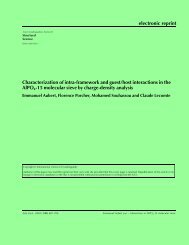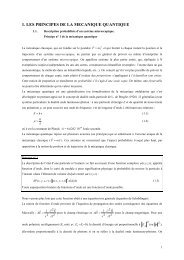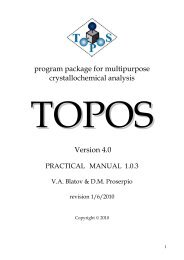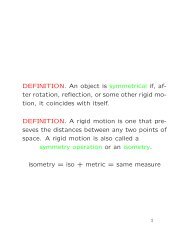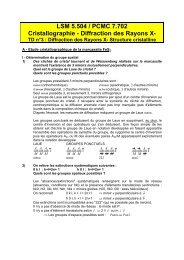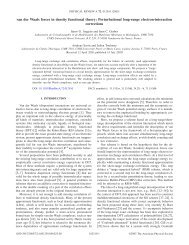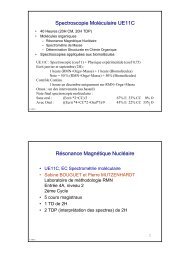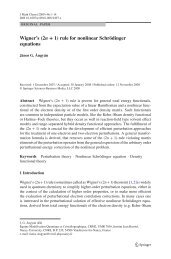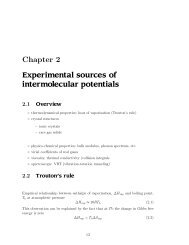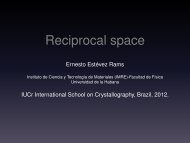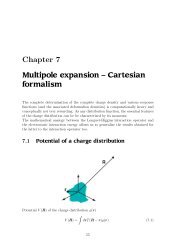Linear Response and Measures of Electron Delocalization ... - CRM2
Linear Response and Measures of Electron Delocalization ... - CRM2
Linear Response and Measures of Electron Delocalization ... - CRM2
You also want an ePaper? Increase the reach of your titles
YUMPU automatically turns print PDFs into web optimized ePapers that Google loves.
<strong>Linear</strong> <strong>Response</strong> <strong>and</strong> <strong>Measures</strong> <strong>of</strong> <strong>Electron</strong> <strong>Delocalization</strong> Current Organic Chemistry, 2011, Vol. 15, No. 20 3617<br />
(a) butatriene (CH 2=C=C=CH 2 ) (b) vinylacetylene (HC C CH=CH 2)<br />
Fig. (4). FHLI functions <strong>of</strong> butatriene <strong>and</strong> vinylacetylene.<br />
appear as a single domain, the electrons that contribute to a given<br />
X-Y bond leave their signatures in the form <strong>of</strong> a more-or-less<br />
spacious FHLI domains, located near the atomic centers which<br />
participate in the bonding. The -bond <strong>of</strong> ethane can be recognized<br />
from the two small domains localized on the C-C axis near the<br />
atoms. In the case <strong>of</strong> ethylene the four electrons <strong>of</strong> the double bond<br />
appear as symmetrically arranged lobes above <strong>and</strong> below the<br />
molecular plane, corresponding to a “banana-type” representation.<br />
The triple bond in acetylene can be recognized from the cylindric<br />
shapes located near the carbon atoms.<br />
In the case <strong>of</strong> isomeric C 4 H 4 structures <strong>of</strong> butatriene <strong>and</strong><br />
vinylacetylene, one can distinguish the triple <strong>and</strong> double bonds in<br />
the latter, while in the butatriane one clearly sees the allen-like<br />
arrangement <strong>of</strong> three double bonds. It is interesting to observe in<br />
butatriene that the two central atoms contribute by significantly less<br />
spacious in-plane lobes than the terminal atoms. In the case <strong>of</strong><br />
vinylacetylene, the deformation <strong>of</strong> the disks representing the triple<br />
bonds is obviously due to the perturbative effect <strong>of</strong> the molecular<br />
skeleton (Fig. 4).<br />
In the case <strong>of</strong> aminoacetylene (Fig. 5a) the most significant<br />
structure is the double disk <strong>of</strong> the triple bond. Around the NH 2<br />
group, the H atoms <strong>and</strong> the lone pair form an almost regular 3-fold<br />
symmetric arrangement. The methylenimine (Fig. 5b), which is isoelectronic<br />
with ethylene one can observe a kind <strong>of</strong> fusion <strong>of</strong> the<br />
nitrogen lone pair <strong>and</strong> the p z -like lobes <strong>of</strong> the double bond located<br />
on the same nitrogen.<br />
localized electrons are less, delocalized electron are more<br />
polarizable - can be put in more precise terms <strong>and</strong> establish a clear<br />
relationship with the more conventional descriptors <strong>of</strong> electron<br />
localization, based on the xc-hole or more specifically on the<br />
Fermi-hole <strong>and</strong> its properties. The view advocated in this account is<br />
inspired by recent developments in solid state electronic structure<br />
theory, based on a parallel between the modern theory <strong>of</strong><br />
polarization <strong>and</strong> the notion <strong>of</strong> electron localization. It has been<br />
shown that the Resta localization index, used until now almost<br />
exclusively as a global measure to characterize the itinerant or nonitinerant<br />
character <strong>of</strong> electrons in solids, can be <strong>of</strong> some utility for<br />
molecular systems as well. Moreover, using experimental dipole<br />
oscillator strength distributions, the localization index seems to be<br />
accessible on experimental grounds as well.<br />
The fluctuation or covariance <strong>of</strong> the domain populations in a<br />
molecule, widely used as coarse-grain measures to describe<br />
localization <strong>and</strong> delocalization between atoms (or other domains)<br />
has been related to the charge-flow polarizability, which can be<br />
derived directly from the charge density response function. The<br />
approximate proportionality between charge-flow polarizabilities<br />
<strong>and</strong> delocalization indices has been illustrated on a few selected<br />
examples.<br />
Orbital localization criteria can also be reformulated as a<br />
requirement <strong>of</strong> constructing the most transferable <strong>and</strong> therefore the<br />
less polarizable set <strong>of</strong> one-electron functions. The Boys localization<br />
criterion is based on the dipole fluctuation, while the Pipek-Mezey<br />
<strong>and</strong> related criteria can be derived from the requirement <strong>of</strong> minimal<br />
fluctuation <strong>of</strong> atomic (or domain) populations.<br />
Finally, it has been shown that the Fermi hole locality indicator,<br />
which is able to characterize the electron localization by measuring<br />
some non-local features <strong>of</strong> the Fermi-hole, integrates to an<br />
approximate value <strong>of</strong> the second cumulant moment, thereby related<br />
again to the linear response function.<br />
Hopefully, the above cited examples could illustrate the<br />
intimate link between the basic physical mechanisms that govern<br />
the response properties <strong>of</strong> an electronic system <strong>and</strong> the specific<br />
organization <strong>of</strong> fermions, which leads to the important chemical<br />
concept <strong>of</strong> electron localization.<br />
8. ACKNOWLEDGEMENTS<br />
The author is grateful to Dr. A. Savin (Paris) for reading the<br />
manuscript <strong>and</strong> for his comments. The financial support <strong>of</strong> the<br />
Agence Nationale de la Recherche (ANR) in the framework <strong>of</strong> the<br />
project WADEMECOM (ANR-07-BLAN-0272) is gratefully<br />
acknowledged.<br />
REFERENCES<br />
(a) aminoacetylene (HC C NH )<br />
2<br />
(b) methylenimine (CH2 =NH)<br />
Fig. (5). FHLI functions <strong>of</strong> methylenimine <strong>and</strong> aminoacetylene.<br />
Further examples have been presented in Ref. [64], which<br />
demonstrate that the FHLI is able to provide an useful pictorial<br />
representation <strong>of</strong> the electron pair structure <strong>of</strong> molecules.<br />
7. CONCLUSIONS<br />
The electron localization/delocalization problem has been<br />
presented from the viewpoint <strong>of</strong> the linear response properties <strong>of</strong><br />
the molecular charge density to an external electric field<br />
perturbation. It has been shown that a seemingly loose statement -<br />
[1] Merino, G.; Vela, A.; Heine, T. Description <strong>of</strong> electron delocalization via the<br />
analysis <strong>of</strong> molecular fields. Chem. Rev. 2005. 105, 3812-3841.<br />
[2] Poater, J.; Duran, M.; Solà, M.; Silvi, B. Theoretical evaluation <strong>of</strong> electron<br />
delocalization in aromatic molecules by means <strong>of</strong> Atoms in Molecules (AIM)<br />
<strong>and</strong> <strong>Electron</strong> Localization Function (ELF) topological approaches. Chem.<br />
Rev. 2005. 105, 3911-3947.<br />
[3] Gatti, C. Chemical bonding in crystals: new directions. Z. Kristallogr. 2005.<br />
220, 399-457.<br />
[4] Cortés-Guzmán, F.; Bader, R.F.W. Complementarity <strong>of</strong> QTAIM <strong>and</strong> MO<br />
theory in the study <strong>of</strong> bonding in donor-acceptor complexes. Coord. Chem.<br />
Rev. 2005. 249, 633-662.<br />
[5] Savin, A. The electron localization function (ELF) <strong>and</strong> its relatives:<br />
interpretations <strong>and</strong> difficulties. J. Mol. Struct. (Theochem) 2005. 727, 127-<br />
131.<br />
[6] Ayers, P.W. <strong>Electron</strong> localization functions <strong>and</strong> local measures <strong>of</strong> the<br />
covariance. J. Chem. Sci. 2005. 117, 441-454.<br />
[7] Bader, R.F.W.; Hernández-Trujillo, J.; Cortés-Guzmán, F. Chemical<br />
bonding: From Lewis to atoms in molecules. J. Comp. Chem. 2007. 28, 4-14.



